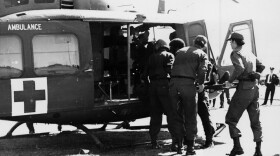Top secret Army experiments exposed thousands of veterans to potential chemical and biological weapons. Some are still waiting for follow up medical care.
For decades during the Cold War, the Army carried out chemical and biological testing experiments on more than 7,000 of its own soldiers at the Edgewood Arsenal in Maryland. The service members - all volunteers - were sworn to secrecy and told they would experience no long-term health effects.
Some soldiers tested protective clothing, while others were exposed to nerve agents, mustard gas, and psychoactive drugs. Most didn't realize what they'd signed up for.
Bob Krafty was just out of his teens in 1965 when the Army offered him temporary duty at Edgewood. The offer was attractive: it would mean no kitchen duty, a private room and three days off per week. The Army told him he'd be helping to end the war in Vietnam.
"I was naive. I was patriotic," said Krafty, who now lives in Venice, Fla. "My government would never hurt me. You know, at first it's embarrassing to know you were sucked in."
Once he arrived at Edgewood, Krafty heard talk of a new chemical warfare strategy that would minimize American casualties.
"I was told that, theoretically, we could take a chemical and dump it behind the enemy lines," he said. "Then in 12 hours, 24 hours, go behind there and gather them up. This way, you're not being killed. You're not killing them."

Krafty remembers the experiments vividly. The Army once put him in a padded room for three days and made him breathe an aerosol pesticide used by the military as a nerve agent.
"They put it over my nose and mouth," he said. "I felt weak - dizzy. They tested us day and night - woke us up during the night taking blood pressure, asking what sensations we're feeling."
Krafty left Edgewood after two months and remained stateside instead of going to Vietnam.
By the time he reached his mid-20s, his hands shook so badly he couldn't do simple tasks. He later developed other health problems, including prostate cancer and symptoms of post-traumatic stress.
It was only decades later that he found out through his own research that he had been exposed to dangerous chemicals. But when Krafty obtained his Army health records and applied for VA disability benefits, he was rejected. The VA said it lacked adequate evidence to show that Krafty's health problems were connected to his time in service.
Notifications slow, incomplete
In 2013, a federal court ruled that the Army had to notify veterans of possible long-term health effects from their time at Edgewood. The same court later required the Army to provide the Edgewood veterans medical care as well.
"Notice is important," said attorney Ben Patterson, "so vets can get proper medical treatment and understand the diagnosis for their particular health problems." Patterson's firm, Morrison and Foerster, is representing the Edgewood test veterans.
In November, the Army began mailing about 4,000 letters to veterans around the country. The letters included applications for medical care, but made no direct mention of Edgewood Arsenal. They also didn't provide any information about the specific chemicals vets were exposed to.
"It's so generic," said Frank Rochelle, who is one of the original plaintiffs in the case. "It's obvious that they didn't even know what they were doing."
Some veterans - like Krafty - never received a letter. Others that did, like Rochelle, face an uphill battle to qualify for care and get their health information.

"The forms they want you to fill out are basically just delaying the whole system, Rochelle said. "They're hoping that we'll die."
But the Army said notifying vets isn't as easy as it sounds.
Bill Fitzhugh at the Army Public Health Center said officials first have to validate where veterans are before releasing any private health information. That's difficult, he said, because some of the records from Edgewood have been destroyed or are difficult to make sense of.
The Army said some veterans didn't receive letters because parts of their names, social security numbers, or serial numbers are missing from its database.
"The major issues that we're talking about is our data is incomplete. The data that we're dealing with sometimes is handwritten notes, notebooks," Fitzhugh said. "It's definitely not automated."
'How many are dying off?'
As of Feb. 1, the Army had received only 64 medical care applications from veterans - 41 of which were complete. An estimated 1,000 test veterans from Edgewood are still alive.
"We have sent over 265 letters to Veteran/Military Service Organizations requesting that they share the information with their members," said a statement from Army Public Health. "We have reached out to the VA, and they have placed the link to our website and a brief description of this program on their websites."
Fitzhugh said it will be a while before the Army's outreach gains traction.
"I was surprised to see how many responses we got as quickly as we did," he said. "But we're expecting to see the number increase over time. And that's just for the known veterans - the ones that we sent out notification letters to. So that's one of the big things we're working on right now: How do we reach out to all of these veterans?"
That's a question Bob Krafty spends a lot of time thinking about. He managed to get a copy of the Army's medical care application on his own. But he says his fellow aging veterans can't wait any longer.
"Let's face it. With the age, how many are dying off? How many don't know about it? In another 30 years, we're all gonna be gone," he said. "Then Edgewood Arsenal is kind of going to go away."
This story was produced by the American Homefront Project, a public media collaboration that reports on American military life and veterans. Funding comes from the Corporation for Public Broadcasting and the Bob Woodruff Foundation.




